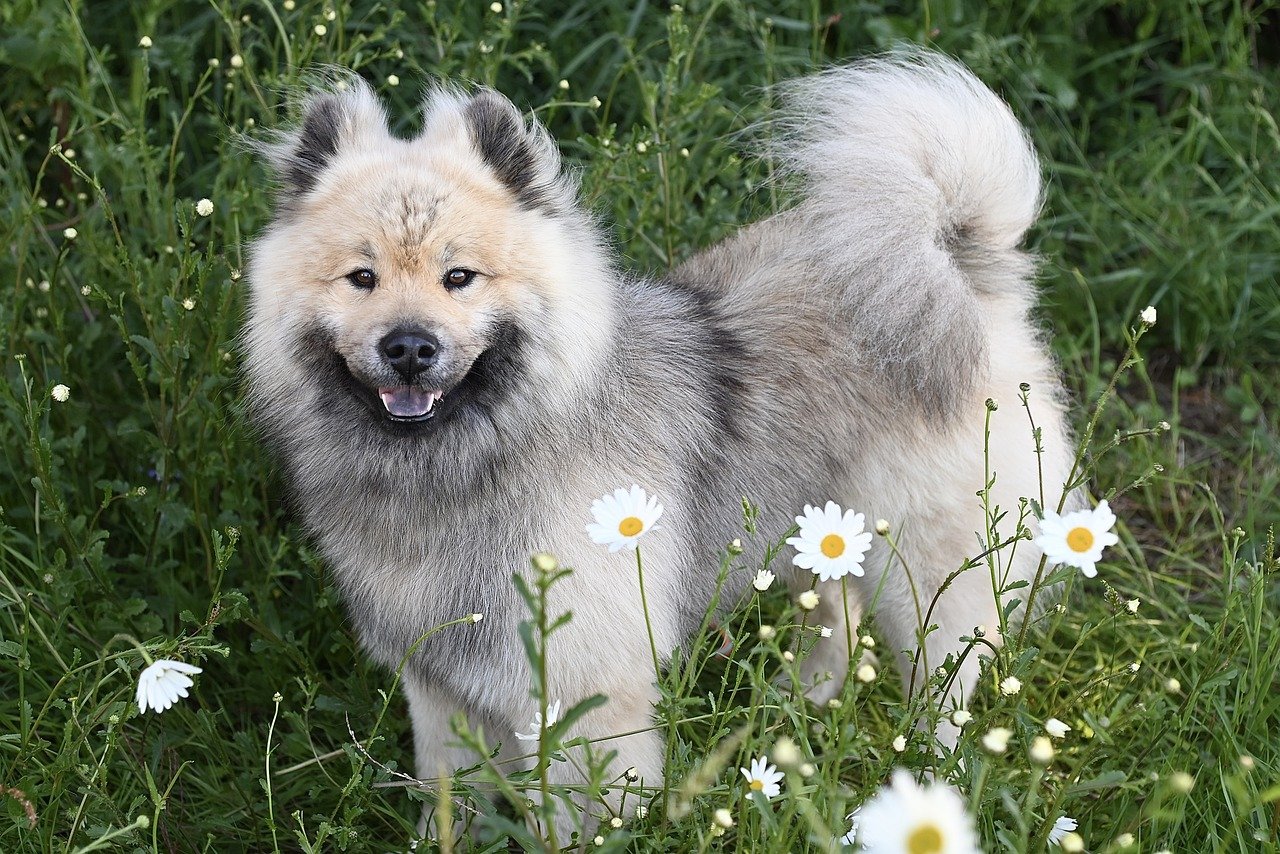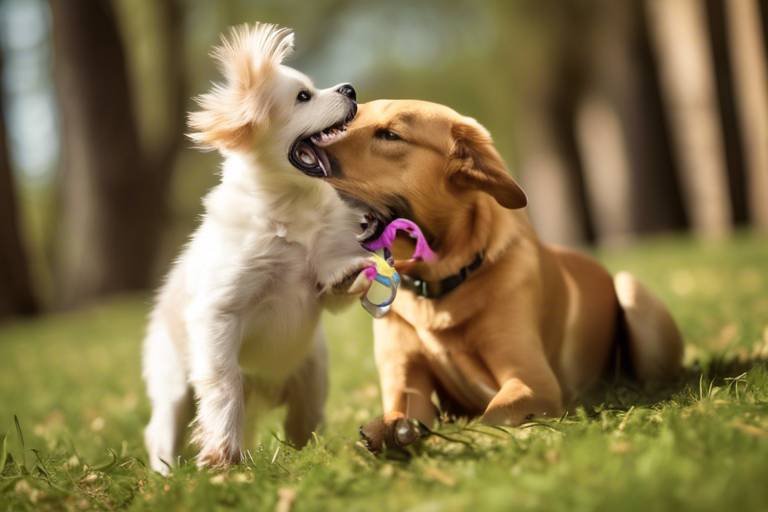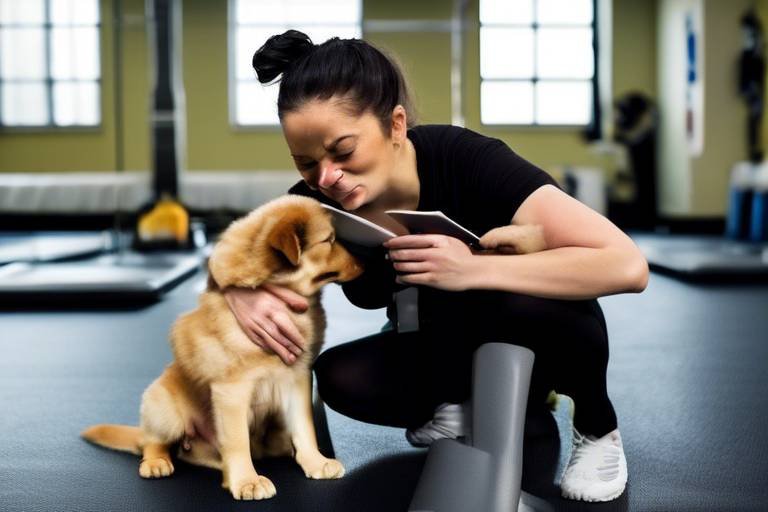The Benefits of Enrichment Activities for Dogs
Dogs are more than just pets; they are our companions, and just like us, they need to be engaged both physically and mentally. Enrichment activities are an essential part of a dog's life, providing them with the stimulation they crave. Think of these activities as a buffet for your dog's mind and body, offering a variety of experiences that keep them happy, healthy, and well-adjusted. By incorporating enrichment into your dog's routine, you're not just filling their day with fun; you're also enhancing their overall quality of life.
Imagine a world where your dog is not just lying around, bored and restless, but instead, they are actively exploring, learning, and interacting with their environment. This is the magic of enrichment activities! They can range from simple games to complex training exercises, all designed to tap into a dog's natural instincts and behaviors. When you engage your dog in these activities, you're not just fulfilling their needs; you're also creating a deeper bond that can last a lifetime. So, let’s dive into the various benefits that enrichment activities can bring to your furry friend!
Canine enrichment refers to activities that stimulate a dog's mind and body. It includes various forms of play, training, and exploration that cater to their natural instincts and behaviors. Imagine your dog as a little explorer, eager to sniff out new scents or solve puzzles that challenge their intellect. Enrichment can take many forms, such as interactive toys that dispense treats, outdoor adventures that engage their senses, or even simple training sessions that encourage them to think critically.
Engaging in enrichment activities promotes physical fitness in dogs. Regular exercise helps maintain a healthy weight, strengthens muscles, and improves cardiovascular health, contributing to a longer, happier life. Think of it this way: just like humans, dogs need to stay active to avoid health issues. A dog that is regularly engaged in physical activities is less likely to suffer from obesity-related diseases, joint problems, or lethargy. Plus, a tired dog is a happy dog!
Enrichment activities challenge dogs mentally, enhancing their problem-solving skills and cognitive functions. Puzzles, games, and training exercises can keep their minds sharp and engaged, reducing boredom and destructive behaviors. It’s like giving your dog a workout for their brain! When dogs are mentally stimulated, they are less likely to engage in unwanted behaviors like chewing on furniture or barking excessively. Instead, they channel their energy into productive activities, leading to a more peaceful home environment.
Different forms of mental enrichment include interactive toys, scent games, and training sessions. These activities encourage dogs to think critically and creatively, fostering a sense of accomplishment and satisfaction. For instance, using a puzzle feeder can turn mealtime into an exciting challenge, requiring your dog to figure out how to get their food. Scent games can unleash their inner detective, allowing them to use their incredible sense of smell to find hidden treats. The possibilities are endless!
Social enrichment is crucial for a dog's emotional health. Activities that involve interaction with other dogs or people help improve their social skills and reduce anxiety and fearfulness. Dogs are pack animals by nature, and they thrive on social connections. Whether it's a playdate with a fellow canine friend or a trip to the dog park, these interactions help build confidence and can significantly improve your dog's overall demeanor.
Participating in enrichment activities together strengthens the bond between dogs and their owners. Shared experiences create trust and understanding, leading to a more harmonious relationship and better communication. Imagine the joy on your dog's face as they successfully complete a new trick you taught them or the excitement of exploring a new trail together. These moments not only enrich your dog's life but also deepen your connection with them.
Inadequate stimulation often leads to behavioral problems in dogs. Enrichment activities can help mitigate issues such as excessive barking, chewing, and digging by providing healthy outlets for their energy and instincts. Instead of viewing these behaviors as nuisances, consider them a cry for help. Your dog is telling you they need more engagement in their life. By introducing structured enrichment activities, you can redirect that energy into positive behaviors.
Establishing a routine that incorporates enrichment activities can provide dogs with a sense of security and predictability. This structure helps alleviate anxiety and fosters a calm environment. Just like us, dogs feel more comfortable when they know what to expect. Incorporating daily enrichment into your dog's schedule can be as simple as setting aside time for a walk, a training session, or a fun game of fetch. This predictability can help reduce stress and promote a more balanced emotional state.
Dog owners can easily implement enrichment activities at home. Simple changes, such as puzzle feeders, DIY obstacle courses, and interactive play, can significantly enhance a dog's quality of life. You don’t need to spend a lot of money on fancy toys or equipment; creativity is your best friend here! Use household items to create fun challenges, or take advantage of your backyard for outdoor adventures. The key is to keep things fresh and exciting for your furry friend.
- What are some easy enrichment activities I can do at home? Simple activities include hide-and-seek, using puzzle toys, and creating scent trails with treats.
- How often should I engage my dog in enrichment activities? Aim for at least 30 minutes to an hour of enrichment activities daily, depending on your dog's energy level.
- Can enrichment activities help with anxiety? Yes! Engaging your dog in regular enrichment can help reduce anxiety by providing mental stimulation and a structured routine.

Understanding Canine Enrichment
Canine enrichment is more than just a trendy term thrown around in pet circles; it’s a vital aspect of a dog's life that can significantly enhance their overall well-being. Imagine how you feel after a long day at work, only to come home and find a fresh puzzle waiting for you. That sense of excitement and mental engagement is exactly what enrichment activities provide for our furry friends. By engaging in activities that stimulate both their minds and bodies, dogs can express their natural instincts and behaviors in healthy ways.
So, what exactly does canine enrichment entail? It includes a variety of activities designed to challenge and engage dogs, catering to their unique needs and instincts. Think of it as a buffet of experiences that not only satisfy their cravings for mental and physical stimulation but also keep them from getting bored and destructive. From interactive games to training sessions, the possibilities are endless. Here’s a quick breakdown of the different types of enrichment:
- Physical Enrichment: Activities that promote exercise, such as fetch, agility courses, or simple walks in new environments.
- Mental Enrichment: Engaging puzzles, scent games, and training exercises that challenge a dog's cognitive abilities.
- Social Enrichment: Opportunities for dogs to interact with other dogs or people, which can enhance their social skills and reduce anxiety.
One of the most exciting aspects of canine enrichment is that it can be tailored to fit any dog's personality and energy level. For instance, a high-energy breed might thrive on agility training or fetch, while a more laid-back dog may prefer puzzle toys or leisurely scent games. The key is to observe your dog and discover what activities resonate with them the most.
Moreover, enrichment activities are not just beneficial for the dogs; they also foster a deeper connection between the pet and the owner. When you engage in these activities together, you’re not just providing your dog with entertainment; you’re building trust, understanding, and a meaningful relationship. Enrichment can turn an ordinary day into an extraordinary adventure, filled with learning and bonding.
In summary, canine enrichment is essential for a dog’s mental and physical health. By providing varied and stimulating activities, you help your furry friend live a happier, healthier life. So, the next time you think about how to keep your dog entertained, remember that enrichment is not just a luxury—it’s a necessity!

Physical Health Benefits
Engaging in enrichment activities is not just a fun pastime for dogs; it plays a crucial role in their physical health. Think of it as a gym session for your furry friend! Just like humans, dogs need regular exercise to maintain their fitness and overall well-being. When you incorporate enrichment activities into their daily routine, you’re essentially giving them a workout that keeps their bodies in top shape.
Regular physical activity helps maintain a healthy weight, which is essential in preventing obesity-related health issues. Obesity can lead to serious problems like diabetes, joint issues, and heart disease. By engaging your dog in activities such as fetch, tug-of-war, or even agility training, you’re helping them burn off those extra calories and keep their weight in check. Moreover, these activities strengthen their muscles and improve cardiovascular health, which contributes to a longer, happier life.
But it’s not just about the physical aspects; the mental stimulation gained from these activities is equally significant. When dogs are physically active, they release endorphins—those feel-good hormones that can elevate their mood. This means a happier dog at home, which translates to a more enjoyable experience for both of you!
Let’s take a closer look at some of the specific that enrichment activities can provide:
| Benefit | Description |
|---|---|
| Weight Management | Regular exercise helps maintain a healthy weight, reducing the risk of obesity. |
| Muscle Strength | Activities like running and climbing improve muscle tone and strength. |
| Cardiovascular Health | Physical activities enhance heart health and overall endurance. |
| Joint Health | Regular movement keeps joints flexible and reduces the risk of arthritis. |
Additionally, engaging in activities that promote physical health can also lead to better sleep patterns for your dog. Just like us, dogs need a good night’s sleep to recover from their daily adventures. When they’re physically active, they’re more likely to sleep soundly, which contributes to their overall health and happiness.
Incorporating enrichment activities into your dog's life doesn’t have to be complicated. Simple activities like daily walks, playing fetch in the yard, or setting up a DIY obstacle course can make a world of difference. So, the next time you think about your dog's physical health, remember that a little enrichment can go a long way!
- What are some easy enrichment activities I can do at home?
Some easy activities include puzzle feeders, hide-and-seek games, and creating an obstacle course with household items.
- How often should I engage my dog in enrichment activities?
It’s best to incorporate some form of enrichment daily, but the frequency can vary based on your dog’s energy levels and health.
- Can enrichment activities help with behavioral issues?
Absolutely! Providing physical and mental stimulation can reduce destructive behaviors stemming from boredom.
Mental Stimulation and Cognitive Skills
Mental stimulation is like a workout for your dog's brain. Just as we need to challenge our minds to stay sharp, our furry friends thrive on activities that engage their cognitive skills. Think of it this way: if you were stuck in a room with nothing to do, wouldn't you get bored? Dogs feel the same way when they lack mental engagement. Enrichment activities not only provide entertainment but also enhance their problem-solving abilities and cognitive functions.
Engaging your dog in puzzles or interactive games can be incredibly rewarding. For instance, consider using toys that dispense treats when solved. These toys require your dog to think critically and use their natural instincts, such as pawing or nudging, to unlock the reward. This not only keeps them busy but also gives them a sense of accomplishment. When dogs successfully solve a puzzle, their brains release dopamine, the "feel-good" hormone, which reinforces their behavior and encourages them to seek out more challenges.
Moreover, training exercises can play a crucial role in sharpening your dog's mental acuity. Simple commands like "sit," "stay," or more complex tricks can stimulate their minds while reinforcing good behavior. It’s like giving them a mental gym session! When you incorporate training into their daily routine, your dog learns to focus, listen, and respond, which are essential skills that contribute to their overall well-being.
Additionally, incorporating scent games can significantly enhance your dog's cognitive skills. Dogs have an incredible sense of smell—up to 100,000 times more acute than humans! Utilizing this natural ability can turn a simple walk into an exciting adventure. Hide treats around your house or yard and encourage your dog to find them using their nose. This not only stimulates their mind but also taps into their instincts, making the activity both fun and fulfilling.
In conclusion, enriching your dog's life with mental stimulation is not just a luxury; it's a necessity for their happiness and health. By incorporating various activities that challenge their cognitive skills, you can reduce boredom and destructive behaviors while enhancing their overall quality of life. Remember, a mentally stimulated dog is a happy dog!
- What are some simple enrichment activities I can do at home? You can create a DIY obstacle course, use puzzle feeders, or engage in scent games to stimulate your dog's mind.
- How often should I engage my dog in enrichment activities? Aim for at least 15-30 minutes of mental stimulation each day, in addition to their regular physical exercise.
- Can enrichment activities help with behavioral issues? Yes, providing mental stimulation can reduce behaviors like excessive barking and chewing, as dogs have a healthy outlet for their energy.
Types of Mental Enrichment
Mental enrichment is a crucial aspect of a dog's overall well-being, and there are numerous ways to keep your furry friend mentally stimulated. Engaging your dog in activities that challenge their mind is essential for their happiness and health. One of the most popular forms of mental enrichment is the use of interactive toys. These toys often require dogs to solve a puzzle to access treats or rewards, keeping them engaged for extended periods. Imagine your dog pawing at a toy, trying to figure out how to get that delicious treat hidden inside—it’s like a game of chess for them!
Another exciting avenue for mental enrichment is through scent games. Dogs have an incredible sense of smell, and utilizing this natural talent can be both fun and rewarding. You can hide treats around your home or yard and let your dog sniff them out. This not only engages their mind but also taps into their instinctual behaviors, making them feel accomplished and satisfied. Think of it as a treasure hunt where your dog is the treasure hunter, eagerly searching for hidden goodies!
Training sessions also play a significant role in mental enrichment. Teaching your dog new tricks or commands is not only a great bonding experience but also stimulates their brain. Dogs thrive on learning, and the challenge of mastering a new skill can be incredibly fulfilling for them. Consider incorporating a variety of commands and tricks to keep things fresh and exciting. You might be surprised at how quickly your pup picks up new skills!
To summarize, here are some effective types of mental enrichment you can easily implement:
- Interactive Toys: Toys that require problem-solving to access treats.
- Scent Games: Activities that utilize your dog’s sense of smell to find hidden items.
- Training Sessions: Teaching new tricks or commands to stimulate their brain.
By incorporating these types of mental enrichment into your dog's daily routine, you can help prevent boredom and its associated behavioral issues. Plus, it’s an excellent way to enhance your bond with your furry companion. So, why not give it a try? Your dog will thank you with wagging tails and happy barks!
Importance of Social Interaction
When we think about our furry friends, it's easy to forget that they are social creatures by nature. Just like humans, dogs thrive on social interaction. Engaging with other dogs and people is not just a fun activity; it plays a crucial role in their emotional well-being. Have you ever noticed how your dog lights up at the sight of another pup? That's not just excitement; it's a fundamental part of their nature. Social interaction helps dogs develop their social skills, reduces anxiety, and fosters a sense of belonging.
Imagine if you were stuck at home all day with no one to talk to or play with. It would get pretty lonely, right? The same goes for dogs. When they have opportunities to interact, whether it's through playdates at the park or casual strolls with fellow dog owners, they learn important cues about communication and behavior. These interactions can significantly reduce feelings of fearfulness and aggression, making them more confident and well-adjusted.
Moreover, social enrichment can take many forms. Here are a few examples:
- Dog Parks: A fantastic place for dogs to meet others and engage in playful activities.
- Training Classes: These not only teach your dog new skills but also allow them to interact with other dogs and their owners.
- Playdates: Arranging playdates with friends who have dogs can provide a safe and familiar environment for socialization.
Additionally, social interactions can help mitigate behavioral issues. Dogs that are well-socialized are less likely to develop problems such as excessive barking, digging, or chewing. They learn to express their energy in more appropriate ways, which can lead to a more peaceful home environment. So, if you want to ensure your dog is happy and healthy, consider incorporating regular social activities into their routine.
In conclusion, the importance of social interaction cannot be overstated. It enriches their lives, enhances their emotional health, and strengthens the bond they share with you. By encouraging your dog to socialize, you're not just giving them a good time; you're investing in their overall happiness and well-being.
Q: How often should my dog socialize with other dogs?
A: Ideally, your dog should have opportunities to socialize several times a week. However, this can vary based on your dog's personality and comfort level.
Q: What if my dog is shy or fearful around other dogs?
A: It's important to introduce them to social settings gradually. Consider starting with one-on-one interactions with calm, friendly dogs before moving on to larger groups.
Q: Are there any signs that my dog is not enjoying social interactions?
A: Yes, signs of discomfort can include excessive barking, hiding, or trying to escape. If you notice these behaviors, it may be best to remove your dog from the situation and try again later.
Enhancing the Human-Dog Bond
When it comes to our furry friends, the bond we share is truly special. Engaging in enrichment activities not only provides your dog with physical and mental stimulation but also strengthens the connection between you and your pet. Think of it as a shared adventure, where both of you explore new territories of trust and understanding. Have you ever noticed how a simple game of fetch can turn into a playful dance of joy? That's the magic of enrichment!
Participating in activities together creates a sense of teamwork. Whether it's a challenging puzzle toy or a fun agility course, these experiences allow you to communicate without words, building a bridge of understanding. For instance, when you train your dog to perform a trick, you're not just teaching them; you're also learning about their personality, their likes, and their quirks. It's like peeling back the layers of an onion, revealing a deeper connection with every interaction.
Moreover, the joy of shared accomplishments cannot be overstated. When your dog successfully completes a task, the happiness radiates from them, and you can’t help but feel proud. This sense of achievement fosters a positive reinforcement loop, where both of you feel motivated to engage more. Imagine how rewarding it is to see your dog’s tail wagging furiously after they’ve mastered a new trick or navigated an obstacle course. It’s a celebration of your partnership!
Additionally, regular enrichment activities can help in reducing anxiety and behavioral issues, which in turn leads to a more harmonious relationship. Dogs that participate in engaging activities are less likely to exhibit destructive behaviors, which can often stem from boredom or frustration. By keeping them mentally and physically stimulated, you create a calm and balanced environment that benefits both of you.
So, how can you incorporate more enrichment activities into your routine? Consider setting aside dedicated time each week for fun and games. This could be as simple as a daily walk in a new park, a weekend trip to a dog-friendly beach, or even setting up a scavenger hunt in your backyard. The key is to make these moments enjoyable and rewarding for both you and your dog.
In essence, the more time you spend engaging in enriching activities, the stronger your bond will become. It’s a win-win situation where your dog’s happiness and well-being directly reflect in your relationship. Remember, every game played, every trick learned, and every adventure shared brings you one step closer to a deeper, more fulfilling connection with your canine companion.
- What are some simple enrichment activities I can do at home?
Simple activities include puzzle toys, hide-and-seek games, and scent trails using treats. - How often should I engage my dog in enrichment activities?
It's ideal to incorporate enrichment activities into your dog's daily routine, aiming for at least 30 minutes of mental and physical stimulation each day. - Can enrichment activities help with my dog's anxiety?
Yes, providing structured enrichment can alleviate anxiety by keeping your dog engaged and focused on positive activities.

Reducing Behavioral Issues
When it comes to our furry friends, we all want them to be happy and well-adjusted, right? Unfortunately, many dogs face behavioral issues due to a lack of stimulation and engagement. Just like humans, dogs need mental and physical challenges to thrive. Without these, you might find your pup engaging in less-than-desirable behaviors such as excessive barking, chewing on furniture, or digging up your prized garden. But fear not! Enrichment activities are here to save the day!
Think of enrichment activities as a toolbox for your dog's happiness. By providing them with various outlets for their energy and instincts, you can significantly reduce these behavioral problems. For instance, when dogs are mentally stimulated through puzzle toys or engaging games, they become less likely to resort to destructive behaviors out of boredom. It’s like giving them a job to do; suddenly, they have a purpose, and their energy is channeled positively.
Moreover, implementing a variety of enrichment activities can help address specific behavioral concerns. For example, if your dog tends to bark excessively, you might want to incorporate activities that require concentration and focus, such as scent work or hide-and-seek games. These activities not only keep your dog occupied but also teach them to channel their energy in a constructive way. Here’s a quick look at how enrichment can target specific issues:
| Behavioral Issue | Recommended Enrichment Activity |
|---|---|
| Excessive Barking | Scent games and interactive toys |
| Destructive Chewing | Chew toys and puzzle feeders |
| Digging | Outdoor digging pit with toys |
Additionally, creating a structured routine that incorporates these activities can provide your dog with a sense of security and predictability. Dogs thrive on routine, and when they know what to expect, their anxiety levels decrease. Imagine your dog looking forward to their daily puzzle time or play session; it’s like a little gift they get to unwrap each day!
So, how can you get started? It’s simpler than you might think! Begin by observing your dog's interests and energy levels. Tailor the enrichment activities to suit their needs—some dogs might love interactive play, while others may prefer solo activities like puzzle toys. The key is to mix things up and keep it exciting. Remember, a happy dog is a well-behaved dog!
- What are some signs that my dog needs more enrichment? If your dog is displaying destructive behaviors, excessive barking, or seems lethargic and disinterested, it might be time to amp up their enrichment activities.
- How much time should I dedicate to enrichment activities? Aim for at least 30 minutes to an hour of structured enrichment activities each day, but feel free to incorporate shorter sessions throughout your dog’s routine.
- Can I use regular toys for enrichment? Absolutely! Many regular toys can be used creatively for enrichment. Just think about how you can make playtime more challenging and engaging.
Creating a Structured Routine
Establishing a structured routine for your dog is not just about keeping them busy; it’s about providing them with a sense of security and predictability in their daily lives. Just like humans, dogs thrive on consistency. Imagine how chaotic life would feel without a schedule! By creating a routine that incorporates enrichment activities, you can help your furry friend feel more at ease, ultimately leading to a calmer and happier dog.
Start by identifying the best times during the day to engage your dog in various activities. For instance, mornings can be perfect for a brisk walk or a game of fetch, while afternoons might be suited for puzzle toys or scent games. By setting aside specific times for these activities, you’re not only keeping your dog mentally and physically stimulated but also reinforcing good habits. Think of it as a daily adventure that both you and your dog can look forward to!
Here’s a simple breakdown of how you might structure your dog’s day:
| Time of Day | Activity | Duration |
|---|---|---|
| Morning | Walk or Run | 30 minutes |
| Midday | Puzzle Toys | 20 minutes |
| Afternoon | Training Session | 15 minutes |
| Evening | Interactive Play | 30 minutes |
Incorporating these activities into a routine not only keeps your dog active but also helps in managing their energy levels throughout the day. A well-structured routine can significantly reduce anxiety in dogs, especially those who may be prone to stress or behavioral issues. When dogs know what to expect, they are less likely to engage in destructive behaviors, such as chewing on furniture or excessive barking.
Additionally, consider varying the types of enrichment activities you include in the routine. This keeps things exciting and ensures your dog remains engaged. For instance, you might alternate between outdoor adventures, like hiking or visiting a dog park, and indoor activities, such as teaching new tricks or playing hide-and-seek with their favorite toys. This variety not only stimulates your dog’s mind but also strengthens the bond you share as you explore new experiences together.
Finally, remember to be flexible. While routines are essential, it’s equally important to adapt them to your dog’s needs and energy levels. Some days might call for more vigorous activities, while others may require a more relaxed approach. By listening to your dog and adjusting accordingly, you can create a nurturing environment that promotes well-being and happiness.
- What are some quick enrichment activities I can do at home? Simple activities include using puzzle feeders, hiding treats around the house, or playing tug-of-war.
- How often should I engage my dog in enrichment activities? Aim for at least 30 minutes of structured activity each day, but adjust based on your dog's energy levels and needs.
- What if my dog doesn’t seem interested in enrichment activities? Experiment with different types of activities to find what excites your dog. It might take some time to discover their preferences.
Implementing Enrichment at Home
Implementing enrichment activities at home can be a game-changer for your furry friend. It’s not just about giving them a toy and calling it a day; it’s about creating an environment that stimulates their mind and body. Think of your home as a playground where every corner can offer a new adventure. One of the simplest ways to start is by incorporating puzzle feeders into their mealtime. These feeders require dogs to work for their food, turning a mundane task into a fun challenge. Imagine your dog’s excitement as they figure out how to get to those tasty kibble pieces hidden inside!
Another fantastic idea is to set up a DIY obstacle course in your backyard or living room. Use items you already have at home, like chairs, boxes, and even hula hoops, to create a fun and engaging course. This not only provides physical exercise but also encourages your dog to think critically as they navigate through the course. You could even time them and see if they can beat their previous record, adding a competitive twist to the activity!
Don’t forget about scent games! Dogs have an extraordinary sense of smell, and tapping into this natural instinct can be incredibly enriching. Hide treats around your home and let your dog use their nose to find them. This activity not only stimulates their mind but also satisfies their instinctual behaviors. Imagine the thrill on your dog's face as they sniff out hidden treasures!
Lastly, incorporating regular training sessions can be immensely beneficial. Teaching your dog new tricks or commands not only keeps their mind sharp but also strengthens your bond. It’s like a little mental workout for them, and the best part? They get to show off their new skills, which can be incredibly rewarding for both of you. Plus, who doesn’t love a well-trained dog that can perform tricks on command?
To summarize, creating an enriching environment at home involves a mix of physical activities, mental challenges, and social interactions. Here’s a quick overview of some ideas:
| Activity | Description |
|---|---|
| Puzzle Feeders | Encourages dogs to work for their food, turning mealtime into a stimulating game. |
| DIY Obstacle Course | Utilizes household items to create a fun physical challenge. |
| Scent Games | Hides treats around the house for dogs to find, tapping into their natural sniffing abilities. |
| Training Sessions | Teaches new tricks and commands, enhancing mental stimulation and bonding. |
By incorporating these activities into your dog's daily routine, you can significantly enhance their quality of life while also having a blast together. Remember, the key is to keep things fun and engaging. Your dog will thank you with wagging tails and joyful barks!
- What are some signs that my dog needs more enrichment? Look for signs of boredom, such as excessive barking, chewing, or digging. If your dog seems restless or disinterested in playtime, it might be time to ramp up the enrichment activities.
- How much time should I dedicate to enrichment activities? Aim for at least 15-30 minutes of enrichment activities each day. This can be broken up into short sessions throughout the day, keeping your dog engaged without overwhelming them.
- Can I use store-bought toys for enrichment? Absolutely! There are many fantastic interactive toys available that provide mental and physical stimulation. Just ensure they are safe and appropriate for your dog's size and chewing habits.
- Is it okay to rotate enrichment activities? Yes! Rotating activities keeps things fresh and exciting for your dog. It prevents them from getting bored with the same toys or games and encourages them to stay engaged.
Frequently Asked Questions
- What are enrichment activities for dogs?
Enrichment activities for dogs are various forms of play, training, and exploration that stimulate a dog's mind and body. They cater to a dog's natural instincts and behaviors, keeping them engaged and happy.
- How do enrichment activities benefit my dog's physical health?
Engaging in enrichment activities promotes physical fitness, helping maintain a healthy weight, strengthen muscles, and improve cardiovascular health. This leads to a longer, happier life for your furry friend!
- Can mental stimulation really reduce destructive behaviors?
Absolutely! Mental stimulation challenges your dog's mind, reducing boredom and preventing destructive behaviors like excessive barking, chewing, or digging. It's like giving them a workout for their brain!
- What types of mental enrichment can I provide at home?
You can easily implement mental enrichment at home with interactive toys, puzzle feeders, scent games, and training sessions. These activities encourage critical thinking and creativity in your dog.
- Why is social interaction important for my dog?
Social enrichment is crucial for your dog's emotional well-being. Activities that involve interaction with other dogs or people help improve their social skills and reduce anxiety, making them more confident and well-adjusted.
- How can enrichment activities strengthen the bond between me and my dog?
Participating in enrichment activities together creates shared experiences that build trust and understanding. This leads to a more harmonious relationship, improving communication between you and your furry companion.
- What routine should I establish for my dog's enrichment activities?
Creating a structured routine that includes enrichment activities can provide your dog with a sense of security and predictability. This not only helps alleviate anxiety but also fosters a calm and happy environment.
- Are enrichment activities difficult to implement?
Not at all! You can easily incorporate enrichment activities into your dog's daily life with simple changes like setting up DIY obstacle courses, using puzzle feeders, or scheduling interactive playtime.



















